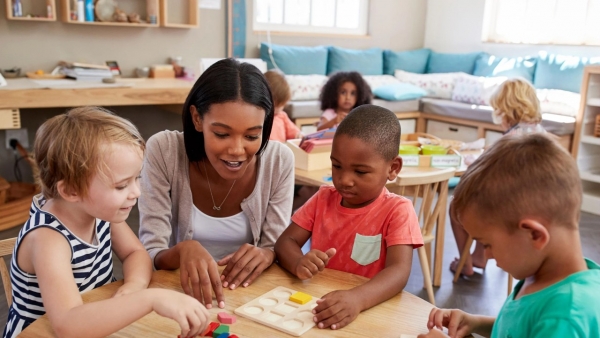It’s no secret that large group instruction, known simply as “large group,” can be a rewarding experience or a hair-pulling, frustrating flop. Depending on the teaching philosophy or approach, large group can be seen as a time to do attendance, talk about daily activities, touch on classroom learnings, or select classroom helpers. Some teachers also create a large group for movement, story time, and group games, while others use this time for children to share and contribute.
As an early childhood education coach at Edmonds College Head Start, I have observed skilled teachers implementing various methods that encourage children to willingly join large group. Teachers often carefully plan transitions, incorporate intentional teaching moments, and create quiet activity tables as a scaffolded support for children not yet ready to join large group.
While these strategies are effective, what has stood out to me most is how skilled teachers create intentional learning opportunities beyond large group. Providing quality adult-child interactions outside of large group ensures that children gain new information and knowledge through everyday conversations with their teachers, and intentional small groups also provide children with opportunities to self-regulate, practice school readiness skills, and work on specific objectives.
Using strategies outside of large group can help to create a child-focused experience and foster a sense of belonging and acceptance throughout each school day.
4 TIPS FOR MOVING BEYOND LARGE GROUP
1. Focus on the children’s experience. Ask yourself: Do the activities or conversations uplift the teacher or the children? Will the children move on with inspiration and excitement or be restless because they sat through a mini-lecture?
Teachers may see large group time as an opportunity to shower the children with their infinite wisdom. However, the best way to learn is by using all of the mind and body: seeing, hearing, speaking, doing, tasting, and touching.
It takes more skill to resist giving all the answers and take the children on the journey of wondering. There is no better reward than guiding a child through self-realization, hearing their amazing theories, or seeing their facial expressions when they make their own discovery.
2. Value the children’s time. Children are human beings with their own motivations and desires. The most effective teachers know that children’s time is valuable, too. Just like when adults go to a staff meeting, children harbor the same concerns. What will I gain during this time? Do I know what is going to happen and what is expected? Will I get to contribute and feel a sense of belonging?
Children feel respected when their words and thoughts are recognized. Teachers can meet these needs through open-ended conversations, writing down children’s words, and engaging children in hands-on activities with real materials. Allowing children to pick the activity, song, or book builds self-esteem. Teachers can create visuals to represent children’s ideas (graphs, voting results, and artwork), chart their responses to questions, and incorporate their ideas into studies.
Additional actions that help children feel respected include going over the schedule of the day (so that everyone knows what is expected and what is coming), using visuals to help make expectations clear, and providing opportunities to contribute responsibly to the classroom community such as through a system of classroom jobs.
Lastly, keep things well timed and avoid dragging things out. We all know the telltale signs of when children are mentally checking out. When children start rolling on the floor and poking friends, it’s time to wrap it up.
3. Understand that not all children are ready for large group. Just like adults, children may experience a variety of emotions while in a group (overwhelm, confusion, distraction, etc.) that can affect their desire to be a part of it. Children may have special needs, may be more physically active in general than their peers, or may still be feeling the effects of an earlier upset.
To some, large group is a new concept. They may need time to warm up to the idea of working with so many other kids. Children with touch aversion or sensory processing disorders may find large group work particularly challenging, and there are always some young students who just prefer to work alone or in small groups.
Even with your best efforts and planning, children may find some activities uninteresting. It’s OK if children wander off. They may need a quiet activity table next to the large group. Perhaps they need special seating. It’s not a reflection on the teacher but rather on where the child is developmentally.
Observations and documentation can provide specific information on what changes may be needed in a given classroom to help children feel more engaged. Building relationships with the children helps teachers get to know their interests and favorite things.
4. Promote a positive experience for all. Teachers are most effective when they feel confident that they know their children well, understand their needs, and have specific plans to support them. When teachers adjust their perspective and think a little deeper about large group, it can open the door for implementing changes that will promote a positive experience for all. Children will feel a part of a community and naturally want to participate with the larger group.
By Ralicia Preisinger








